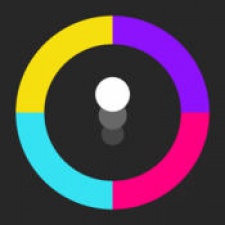Regardless of whether or not you're a fan of the often frustrating - but equally addictive - gameplay of Color Switch, it's impossible to say the game has not been a success.
Originally developed by one man using "codeless" development tool Buildbox, the game was picked up by Fortafy Games, and ended up as the number 1 free game on the App Store in over 100 countries.
But this is old news. What we wanted to know more about was how the game has continued to be a success, and how the developers have effectively monetised it.
To find out more, we spoke to Fortafy Game's co-founder Zeb Jaffer about the ad-supported model, how it was implemented in an originally "codeless" game, and what he thinks about incentivised ads.
PocketGamer.biz: Why do you think Color Switch has been such a success?
Zeb Jaffer: Color Switch is popular for a number of reasons. The core points are the colours, the sounds, the music, and of course, the frustrating and addictive format to tapping a simple ball through the right colour section of an obstacle. Simplicity wins everytime.
I also think there’s a certain amount of pop culture appeal. The game was created by David Reichelt - a color-blind magician with zero coding experience - and that background detail adds to the popularity.
How difficult was it to implement ads into a game built in a codeless development tool?
We worked with a monetisation and mediation platform that made it easy.
Heyzap (now part of Fyber) created a fully automated, stress-free environment that allowed us to focus on game updates, business development and marketing.
We didn’t have to focus on integrating ad networks and doing "manual labour" to get results with advertising.
How have players reacted to the use of ads?
We’ve had ads in the game from the onset, and installs are super-high, retention is high and reviews are above 4.5 stars. I think that answers the question!
Do you think that you could run a successful free-to-play game using just incentivised ads, or will traditional ads always have a place in the mobile gaming space?
You can certainly incorporate both formats.
You can only make money from a game that has traffic.Zeb Jaffer
We initially launched with banners and interstitials, but moved to include rewarded video ads after a month or so.
I guess it boils down to what your road map and end game strategy is.
Do you have thoughts or tips for small development teams that want to monetize pretty quickly after they launch?
Always focus on the game and playability first. You can only make money from a game that has traffic, so advertising should be your secondary priority.
Once you’ve got that, then you can choose a monetisation partner that offers the autopilot functionality, mediation and an algorithm that works really well.
Monetising quickly requires a burden-free environment, and that’s something Heyzap has been able to provide.
But the first step and secret to making money from any advertising or IAP, is really having a game that people want to come back to all the time.
Given the simplicity of the game, there are already a number of copycat games on the App Store. Has this affected your revenue in any noticeable way?
No, not at all. They’re just very bad imitations, and I guess it’s a compliment when people want to steal your ideas. We’re just staying focused on our job at hand.
Could you share any information on your revenues, such as your ARPDAU?
The only stat I can share, is that monetising with rewarded video drove a 40 percent lift in ARPDAU. It works well when the format fits within your game.
What's next for Color Switch, and are there any more games on the way?
We have a healthily-stocked arsenal of surprises ready for our players. I’d just say keep your eyes peeled, your ears open and watch this space.






















